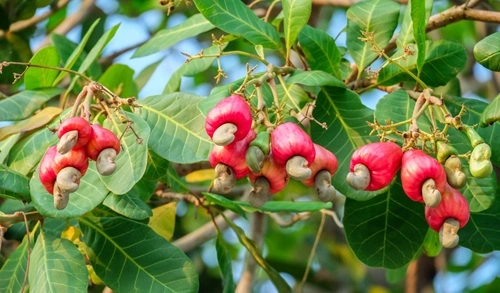Cashew is considered both a nut and a crop, which is grown widely in coastal and semi-coastal areas of the country. It is a high-value crop in terms of economy, and it supports many small farmers’ livelihoods. From rural employment to the processing industry and the export market, the cashew crop is dependent.
In the past several years, the cashew production has been stable compared to a decade ago, where some fluctuation is only seen due to weather, pests, and market demands. As per the recent APEDA estimates, the total raw cashew production in India came around 0.75 to 0.8 million tonnes for 2025, with 0.7 million hectares of land under cultivation.
To understand the flow of the market and the economic side of cashew, it is crucial to learn about which states dominate, their qualities, types, and other key insights. Here, we are sharing the top 5 highest cashew-producing states along with key parameters for in-depth knowledge.

1. Maharashtra – 1,99,700 Tonnes
Maharashtra has always been the top producer of cashew with significant margins. The total production of cashew in 2025 came around 1,99,700 tonnes, which is nearly 26% of the total national cashew production. The dominating region in the production of cashew was the Konkan belt. The top regions are Sindhudurg, Ratnagiri, and Kolhapur. There’s a strong processing industry, helped by proximity to ports and export infrastructure. The only critical issues Maharashtra is facing with cashew production are cyclonic storms, pest infestation, irregular rainfall, and a lack of labour for harvesting and processing.
2. Andhra Pradesh – 1,27,200 Tonnes
Andhra Pradesh also contributed significantly to cashew production as per recent estimates. Andhra Pradesh produced around 1,27,200 tonnes of cashew in 2025, which is about 17% of the total national cashew production. The major districts that dominated the overall production were Srikakulam and Visakhapatnam. The coastal areas benefited from humidity and sandy to lateritic soils, which helped in growth and quality. Andhra also has a well-developed processing sector. However, issues like consistent quality of raw nuts, infrastructure of handling, and drying are major issues.
3. Odisha – 1,21,300 Tonnes
Odisha takes the third position in cashew production with 1,21,300 tonnes of production. Odisha contributed more than 16% in total national output with key districts like Ganjam, Koraput, Rayagada, and the northern coastal belt. There are also forest fringes, which helped in the production of quality cashews. These regions lead with the mix of tribal agriculture and forest agro-systems for cashew plantation. Critical points for Odisha involve improving harvesting and post-harvest handling to reduce losses, securing inputs and seedlings, managing soil health, and enhancing market linkages.
4. Karnataka – 77,900 Tonnes
Karnataka cashew output came around 77,900 tonnes in 2025, with top regions like Udupi, Dakshina Kannada, and Uttara Kannada. These regions have lateritic soil, sufficient rainfall, and perfect humidity to offer favourable conditions for the best quality cashew. Even the yield rate in Karnataka’s western regions is higher than in most places where cashew grows. However, Karnataka is also dealing with some issues like maintaining productivity under older plantations, pests and diseases, and quality processing. The government is supporting farmers through incentives, better technology, and data to ensure more production of cashews.
5. Tamil Nadu – 77,300 Tonnes
Tamil Nadu ranks fifth, producing about 77,300 tonnes of cashew nuts annually in recent estimates. Major cashew cultivation districts include Cuddalore, Villupuram, and Sivaganga. Coastal and near-coastal areas with moderate rainfall, sandy soils, and agroclimatic support help in cashew growing. Tamil Nadu has long been important in kernel quality, grading, and export, though its raw nut production is lower in scale compared to the top three. Issues include maintaining quality, reducing the cost of production, ensuring good drying and storage, and competition with other states.
The Final Verdict
The above five states play an important role in fulfilling the cashew demand and keeping the economy stable in many regions. Cashew is a high economic value crop, and it supports farmers’ livelihood and benefits state governments as well. With the improving technology and better incentives from the government, the production numbers are expected to rise by 2026. The only issue that every state is dealing with is unpredictable climate, which makes things difficult for farmers.